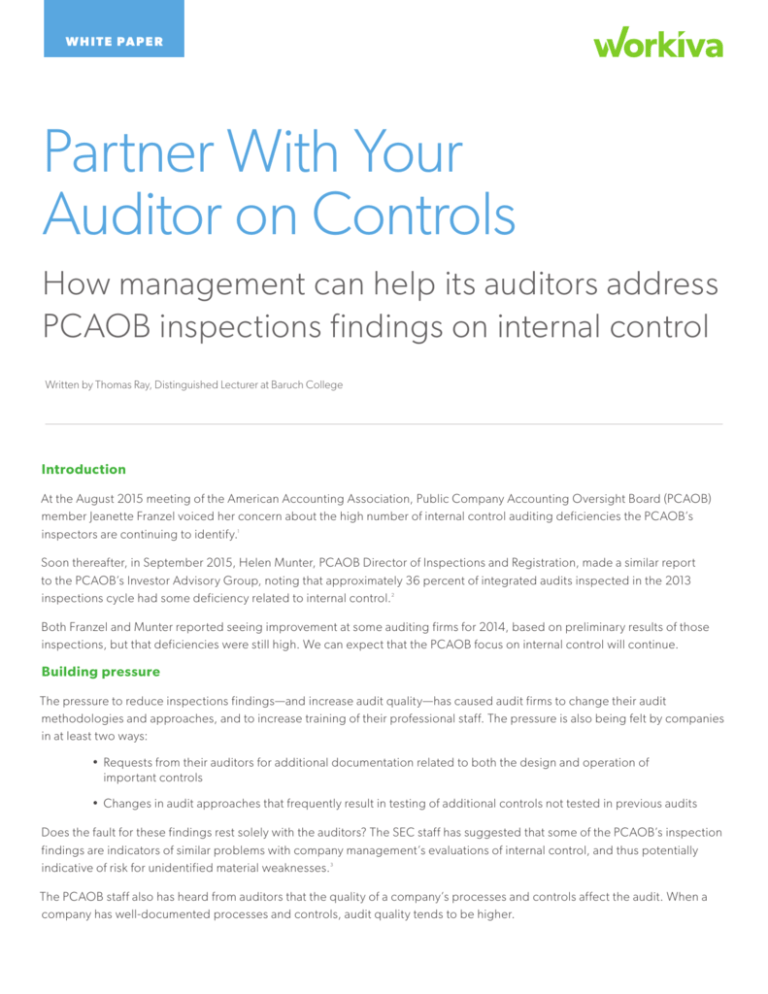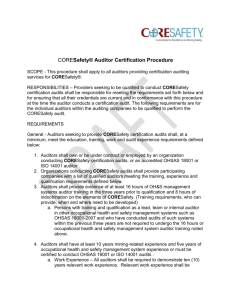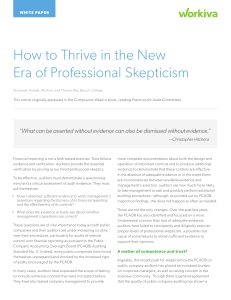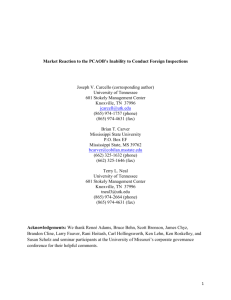Partner With Your Auditor on Controls
advertisement

W H I T E PA P E R Partner With Your Auditor on Controls How management can help its auditors address PCAOB inspections findings on internal control Written by Thomas Ray, Distinguished Lecturer at Baruch College Introduction At the August 2015 meeting of the American Accounting Association, Public Company Accounting Oversight Board (PCAOB) member Jeanette Franzel voiced her concern about the high number of internal control auditing deficiencies the PCAOB’s inspectors are continuing to identify. 1 Soon thereafter, in September 2015, Helen Munter, PCAOB Director of Inspections and Registration, made a similar report to the PCAOB’s Investor Advisory Group, noting that approximately 36 percent of integrated audits inspected in the 2013 inspections cycle had some deficiency related to internal control. 2 Both Franzel and Munter reported seeing improvement at some auditing firms for 2014, based on preliminary results of those inspections, but that deficiencies were still high. We can expect that the PCAOB focus on internal control will continue. Building pressure The pressure to reduce inspections findings—and increase audit quality—has caused audit firms to change their audit methodologies and approaches, and to increase training of their professional staff. The pressure is also being felt by companies in at least two ways: • Requests from their auditors for additional documentation related to both the design and operation of important controls • Changes in audit approaches that frequently result in testing of additional controls not tested in previous audits Does the fault for these findings rest solely with the auditors? The SEC staff has suggested that some of the PCAOB’s inspection findings are indicators of similar problems with company management’s evaluations of internal control, and thus potentially indicative of risk for unidentified material weaknesses. 3 The PCAOB staff also has heard from auditors that the quality of a company’s processes and controls affect the audit. When a company has well-documented processes and controls, audit quality tends to be higher. How public companies can address demands In addition to voicing their concerns, Franzel and Munter highlighted the nature of the most common internal control findings. This paper describes five of the most significant findings and discusses ways in which company management might respond to both improve its internal control and to help its auditors more efficiently obtain the evidence needed to support their internal control audit opinion. 1. Understanding the flow of transactions Understanding the flow of transactions through the company’s accounting system is a critical first step in planning an effective audit. This enables the auditor to identify where misstatements can enter the system and to identify and test the controls that are responsive to the risks. According to the PCAOB, many auditors have failed to gain an adequate understanding. It is hard to imagine that so many auditors have failed in this fundamental objective. What could contribute to such failures? Two potential causes come to mind. The first is that the auditors did not perform the procedures necessary to understand how their clients’ systems worked. Possibly, the systems walkthroughs were not performed by sufficiently competent personnel, were not properly supervised, or were not adequately documented. The second is that their clients’ systems documentation was not complete or current, and the auditing procedures failed to identify the problem. Companies obviously have the most control over the second potential cause. They can also play an active role in helping their auditors obtain and document the understanding and other information they need to appropriately plan and perform their auditing procedures. There are several things every set of accounting systems documentation should include. These are: A. A description of how transactions flow through the system, from their initiation to their inclusion in the company’s financial statements This includes how transactions and other information, such as journal entries, are entered into the system, where transaction and other information that affects financial reporting is stored, and each process, including computer applications and manual processes, that affects the information. The description can be in the form of a flowchart, diagram, narrative, or a combination of these formats. B. Identification of the points in the system at which errors or fraud can occur These points include: • When information enters the system (e.g., at the initiation of a transaction or the posting of a journal entry) • When information moves from one part of the system to another (e.g., from where the information is stored to an application that processes the information) • When data is summarized, aggregated, or otherwise changed (e.g., when a subledger posts to the general ledger or when the general ledger trial balance is summarized into financial statements) C.The controls in place at each point at which errors or fraud can occur that could cause the financial statements to be materially misstated These controls normally should address the financial statement assertions implicit in the transactions or events that affect the company’s financial information, which are: • Occurrence – the recorded transaction or event actually occurred • Completeness – all such transactions or events that occur are captured by the system • Accuracy – the details of the transaction or event are accurately recorded in the company’s records • Classification – the transaction or event is recorded to the correct account • Cutoff – the transaction or event is recorded in the proper accounting period Similar financial statement assertions also relate to: • Ending balances in the financial statements – existence, rights and obligations, completeness, and valuation and allocation • Presentation and disclosure of the financial statements – occurrence, rights and obligations, completeness, classification, and accuracy and valuation Controls also are necessary to prevent or detect material misstatement to the ending balance and presentation and disclosure assertions. The company should document all five internal control components, assuming management is using COSO’s Integrated Framework, including the control environment, risk assessment, control activities, information and communication, and monitoring. The foregoing discussion is focused on the information and communication and control activities components. 2. Testing management review controls After the first year of audits using Auditing Standard No. 2 (AS2)—the PCAOB’s first internal control auditing standard—auditors were encouraged to adopt a top-down, risk-based approach to the identify controls that needed to be tested to increase the efficiency of their internal control audits without reducing their effectiveness. Auditing Standard No. 5 (AS5), AS2’s successor, incorporated this approach into the auditing standard itself. This was largely successful. Auditors replaced the testing of many process-level controls with fewer controls that operated at a higher level within the company, many of which were designed to address more than one financial statement assertion. Several forms of these higher level controls are referred to as management review controls, which often serve as a form of detective control that can help management identify misstatements, including fraud. Unfortunately, a result of the PCAOB’s increased focus on auditor compliance with AS5, which began with the 2010 inspections, the PCAOB has found that auditors: • Were not able to show the PCAOB inspectors that the controls operated at the necessary level of precision • Did not always obtain sufficient evidence that these controls operated effectively Munter noted in her remarks that one explanation some auditors provided for these audit deficiencies is the lack of documentation to support the operation of the controls at the audit client. Thus, it is important to recognize that there are two forms of documentation the auditor is concerned with: documentation of the design of the controls (i.e., the design document) and documentation of their operation. Company management should be satisfied that its documentation in these areas is sufficient to support both its own assessment of internal control effectiveness and its auditor’s. Precision of the control Precision relates principally to the design of the control. The design elements of a management review control that ought to be described include: • The objective of the control, which can be discussed relative to the financial statement assertions affected (e.g., expenses and accounts payable are complete), or the types of misstatements the control is designed to detect (e.g., to detect unrecorded expenses and accounts payable). • The nature and sources of information being subjected to the control as well as other information used as a part of the control operation, including how the reliability of the other information is ensured. (See discussion on testing systems-generated data and reports.) • The way in which the control is expected to be performed. • The steps involved in performing the control and any necessary guidance on how the control operator should exercise judgment. • The level of competence and authority of the control operator necessary to perform the control effectively. • Characteristics of items, circumstances, or other criteria that require follow-up by the control operator, including monetary thresholds, where applicable. This point is critical to understanding the precision of the control, although other items in this list also are important to a control’s precision. • A description of the documentation that is generated as a result of the operation of the control—including how information/evidence used by the control operator is documented and retained, and how the control operator documents significant judgments made in performing the control. This documentation might be automated, or it may need to be prepared by the control operator, depending on the nature of the control. Operating effectiveness When testing the operating effectiveness of a control, the auditor must obtain evidence that the control actually operated and that its operation was effective. Ideally, management’s process will capture this information contemporaneously with the control operation. Information that should be captured in the documentation includes: • Evidence that the control operated • The steps the control operator took in performing the control • The matters identified for follow-up • The information and evidence the control operator obtained and considered • The significant judgments made by the control operator, his or her conclusions, and actions taken to resolve discrepancies • Who performed the control and the date of its performance 3. Testing systems-generated data and reports If a control selected for testing uses system-generated data or reports, the effectiveness of the control depends in part on its accuracy and completeness. Auditors did not always obtain sufficient evidence about that accuracy and completeness. The auditing standards permit the auditor to obtain evidence about the accuracy and completeness of the system-generated data in either of two ways: • By testing the accuracy and completeness of the data directly, such as by testing a sample of the items included in the data • By testing the design and operating effectiveness of the controls over the accuracy and completeness of the data In most cases, it is more efficient for the auditor to test the controls because these controls frequently are automated process-level controls that require a minimal amount of testing. To be able to take advantage of the controls-testing approach, the controls must be in place, be designed, and operate effectively. Management might consider including, as a part of the design documents for management review controls, identification of the controls over the completeness and accuracy of data and reports used by the controls. 4. Selecting the right controls to test Auditors did not always select the appropriate controls to test, missing some that were important to the auditor’s conclusion about whether the company’s controls sufficiently address the assessed risk of misstatement. This audit deficiency is probably closely related to the first one discussed above. If the auditor does not have a sufficient understanding of the flow of transactions through the system, it will be difficult to identify all the controls that require testing. Complete and accurate systems documentation should help auditors alleviate this issue. When performing their systems walkthroughs (i.e., following transactions through the accounting systems from their initiation to their inclusion in the financial statements) and other procedures to obtain and update their understanding of a client’s internal controls, auditors must interact with company personnel. Company personnel should understand the auditor’s objectives. This will increase both the efficiency and effectiveness of the auditor’s work. Company employees also can highlight the controls that they believe are most effective at addressing the misstatement risk. 5. Testing the design effectiveness of the controls selected for testing Auditors did not always sufficiently understand or test the design of the control—that is, whether the control, if operating according to its design, satisfies the control objectives and effectively prevents or detects errors or fraud that could result in a material misstatement. This is principally an evaluation made by the auditor, which may include the auditor reperforming the control. This test is dependent foremost on an accurate understanding of how the control actually operates. Frequently, the auditor will make this evaluation during the systems walkthrough, a procedure that is facilitated by the company’s systems documentation and interaction with the employees responsible for the systems and controls. Company management can be of the most help here by making sure that the systems documentation, including control design documents, is accurate. Management also can help its employees understand the walkthrough process and the objectives the auditor is trying to achieve, thereby increasing the likelihood that the auditors will perform an effective evaluation. Use inspection findings to improve your controls The intense focus on internal control auditing over the past several years has resulted in a more refined understanding of how a system of internal control over financial reporting should be designed and operated. Although there are some concerns that expectations about internal control have gone too far, companies have an opportunity to learn more about internal control by understanding the information the PCAOB is sharing about its inspections findings. 4 Management should think one step beyond the inspections findings as to how its own control systems, including documentation, could be a contributor to the findings, and how it can play a role in alleviating those findings—improving its controls in the process. About the author Thomas Ray is a Distinguished Lecturer in the Stan Ross Department of Accountancy at Baruch College, City University of New York. Previously, Tom served as Chief Auditor and Director of Professional Standards at the Public Company Accounting Oversight Board (PCAOB), where he oversaw the development of Auditing Standard No. 5 and numerous other PCAOB standards and rules. Tom also has held senior positions in KPMG LLP’s national professional practice office and the AICPA, and was a member of COSO’s Advisory Council for the 2013 update to Internal Control: Integrated Framework. Tom is a certified public accountant and provides auditing-related consulting services. He began his career with Grant Thornton LLP. Resources Franzel, Jeannette. “Current Issues, Trends, and Open Questions In Audits of Internal Control over Financial Reporting.” (2015). Public Company Accounting and Oversight Board. Retrieved from http://pcaobus.org/News/Speech/Pages/08102015_ Franzel.aspx 1 Munter, Helen. “Importance of Audits of Internal Controls.” (2015). Public Company Accounting and Oversight Board. Retrieved from http://pcaobus.org/News/Speech/Pages/Munter-Audits-Internal-Control-IAG-09092015.aspx 2 Croteau, Brian. “Remarks Before the 2013 AICPA National Conference on Current SEC and PCAOB Developments — Audit Policy and Current Auditing and Internal Control Matters.” (2013). U.S. Securities and Exchange Commission. Retrieved from http://www.sec.gov/News/Speech/Detail/Speech/1370540472057 3 Quaadman, T. (2015). Center for Capital Markets Competitiveness. Retrieved from http://www.centerforcapitalmarkets.com/ wp-content/uploads/2015/05/2015-5.28-Letter-to-SEC-and-PCAOB.pdf 4 The information contained herein is proprietary to Workiva and cannot be copied, published, or distributed without the express prior written consent of Workiva © 2015. wp1115 workiva.com info@workiva.com +1.888.275.3125








